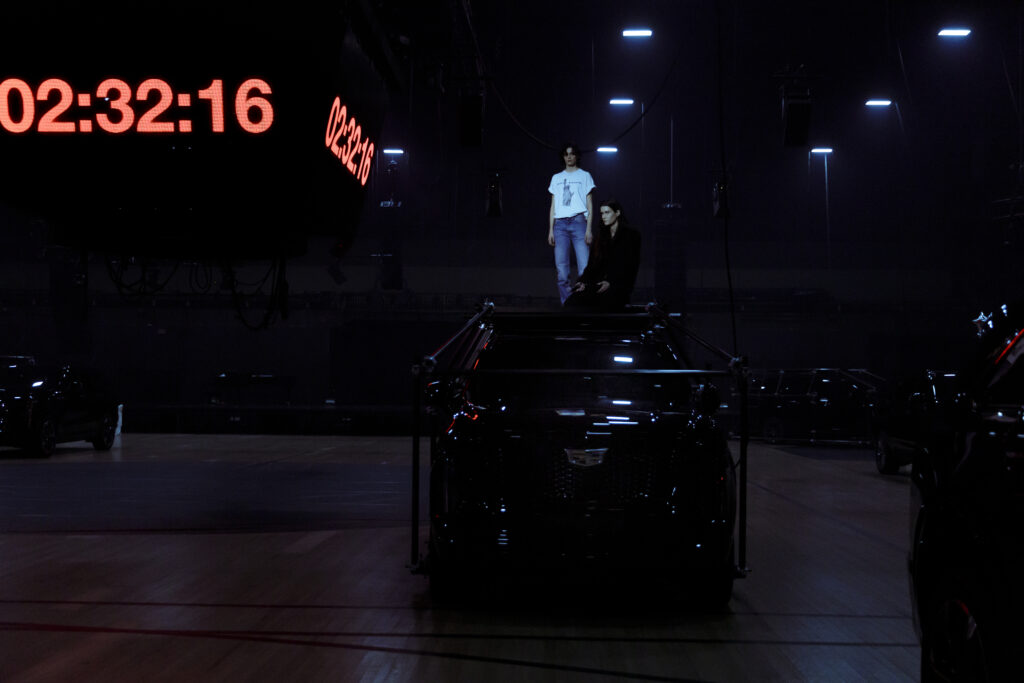Anne Imhof’s Talent Show

Sihana Shalaj and Eliza Douglas in DOOM. Photograph by Nadine Fraczkowski. Courtesy of the artist, Galerie Buchholz, Sprüth Magers, and Park Avenue Armory.
Anne Imhof’s DOOM: House of Hope, a three-hour, influencer-studded “blockbuster” performance of Romeo and Juliet, presents a variation on the talent show more akin to a talent situation. Imhof invents a world in which artistic talent might emanate at any moment, unprompted, from the ranks of a psychically bonded skater mob. Staged around a cavalcade of Cadillac Escalades parked at random diagonals across the Park Avenue Armory’s fifty-five-thousand-square-foot hangar, the show began with a wolf’s howl ringing out from the darkness. The Jumbotron suspended overhead started counting down from 3:00:00, instilling a Hunger Games–esque sense of urgency while a crew of youths, their clothes emblazoned with DOOM in varsity lettering, trickled in to mount the industrial-beam platforms attached to the Escalades. Projecting defiance or disaffection, the actors stared down at us, pantomiming tears trailing down their cheeks.
Finally, the metal gate around the periphery was lowered, and we were free to infiltrate the scene.
Cool kids continually forked off from the clique to launch into choreographed performances, recitations of found texts, or miscellaneous scenes from Shakespeare’s play. Their blocking traversed the Escalades, multiple conventional stages, a semi-secluded white room, and the spotlit center court. The audience was left to roam the hangar but generally gravitated toward the moving center of interest. More intimate moments, like monologues or the dripping of candle wax on naked skin, were filmed on a phone and broadcast in real time on the Jumbotron. Meanwhile, background players kept on gesticulating from the car stages, covertly making out or tattooing one another in the trunks.
My favorite moment was an eloquent speech by a pianist character about the feat of writing about performance from memory. In the carnivalesque House of Hope, all talents are venerated, even the critic’s! I felt seen. Reading the playbill later, I learned that her speech comprised excerpts from famous critics’ obituaries, and the warm feeling faded. The volume of talents on display (rapping, calligraphic skin decoration, contortionism, poetry, ballet, industry-plant rock and roll) gave the show a consistently high entertainment value. Yet DOOM never felt as sprawling or multifarious as the format might have allowed. The audience was never aggressively divided or engaged with directly (no Sleep No More–style kisses on the mouth). No one knew if it was passé to clap after the musical acts.
And the Romeo and Juliet reenactments felt like unmetabolized content within the show’s multimedia gestalt. Shakespeare’s drama was in this instance presubjectively diffused—most of the leads are double- or triple-cast. There is a dancer Romeo and an actor Romeo, singing and skating Tybalts, etc. Nothing quite gels, and we’re left with a random smattering of horseplay fight sequences and the light pathos of Tybalt’s still-vaping “corpse.” If there are warring factions in the House of Hope, it’s the choreographed skater clique versus the disoriented audience.
DOOM: House of Hope’s mash-up of talents and literary allusions was clearly developed in collaboration with the high-profile cast. But unlike most performance artists working in the collaborative vein, Imhof isn’t anti-object. DOOM instead elevates artifacts of the present, showcasing the glossy, streamlined commodities—UberXLs, phones, vapes, glitter belts—that form our denuded monoculture. When Imhof pairs these objects with powerful affective forces like skater coolness/influence and haptic bass tones, it feels like she’s mobilizing everything we’ve got in 2025 (with the merciful exception of memes).
What can we surmise from this bold collage of the present? This aspiration to mythic stability in an increasingly contingent smart world is echoed in the monolithic (literally, black shiny slab) aesthetics of the objects themselves—it functioned well as a piece of design criticism.
Outside the Armory after the show, I asked my friends if I’d missed anything while I was resting, wearily, in the Mylar-balloon-centerpiece Bar Mitzvah table section. Apparently, at one point, a woman had chained herself to one of the Escalades, declaring, “SUVs have no place in art.” Whether this was a part of the performance or a protestor’s intervention is anyone’s guess, although the explicit environmentalist sentiment seems incongruous with Imhof’s tone. In the Bush era, SUVs were a go-to symbol of gas-guzzling hubris, but in DOOM they felt purely architectural, affording visually interesting level shifts reminiscent of Shakespeare’s balcony sequence. The specter of (titular) climate doomerism haunts DOOM, but it is repressed into simplistic schoolyard chants of “DOOM!”/“HOPE!”/“DOOM!”/“HOPE!” Our ecological future is a topic art seems ill-equipped to deal with. Reducing doomerism to white noise is not the right approach, but I’m not sure what would be.
Liby Hays is a writer and artist living in New York. She is the author of Geniacs, a graphic novel about a poet who enters a hackathon, and a codesigner of Conspecifics.
Copyright
© The Paris Review
